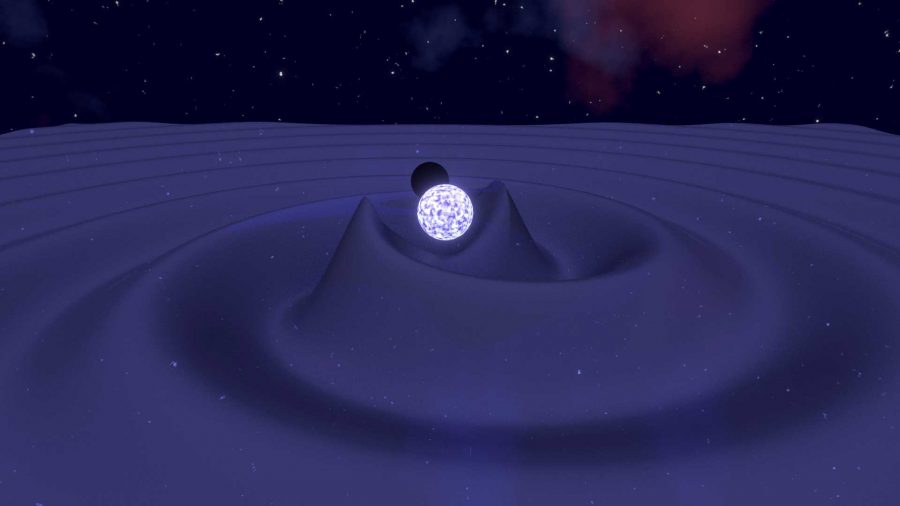Two new detections give astrophysicists a novel look at how stellar remnants pair up.
Astronomers have detected the first two convincing examples of black holes merging with neutron stars. Members of the LIGO, Virgo, and KAGRA collaborations (hereafter LVK) report the discoveries in the July 1st Astrophysical Journal Letters.
Scientists detected the events during the second half of LIGO’s third observing run (called O3b), the full analysis of which is still forthcoming. O3b ran from November 2019 to late March 2020. The two gravitational-wave events, dubbed GW200105 and GW200115, rippled through detectors only 10 days apart, on January 5, 2020, and January 15, 2020, respectively.

Mark Myers (OzGrav /Swinburne University)
Each merger involved a fairly small black hole (less than 10 Suns in heft) paired with an object between 1½ and 2 solar masses — right in the expected range for neutron stars. Observers caught no glow from the collisions, but given that both crashes happened roughly 900 million light-years away, spotting a flash was improbable, even if one happened — and it likely didn’t: The black holes are large enough that they would have gobbled the neutron stars whole instead of ripping them into bite-size pieces.
LVK members have reported a potential black hole–neutron star smashup before, but it’s still unclear whether it’s just gunk in the data. And last summer, they also announced a puzzling collision involving either the most massive neutron star or the smallest black hole known. (The jury’s still out, but at least some astronomers lean toward black hole.) Thus in terms of confidence level, the two new events mark a first for gravitational-wave studies.
Scientific visualization: T. Dietrich (Potsdam University and Max Planck Institute for Gravitational Physics), N. Fischer, S. Ossokine, H. Pfeiffer (Max Planck Institute for Gravitational Physics); Numerical-relativity simulation: S.V. Chaurasia (Stockholm University), T. Dietrich (Potsdam University and Max Planck Institute for Gravitational Physics)
How Did They Form?
The black hole involved in the GW200105 event had a mass of about 9 Suns and appears to have spun slowly, maybe even not at all. That might indicate it’s the core of a collapsed star, although X-ray observations of black holes in stellar binaries problematize that.
Unfortunately, because they’re four to five times more massive than the neutron stars, the black holes in both mergers drown out clear information about their smaller companions’ spins.
Curiously, GW200115’s 6-solar-mass black hole may have spun upside-down with respect to its inspiraling orbit. Objects born as binaries are generally expected to tilt less than 30° from their orbits around each other, so the black hole’s rakish angle might mean it paired up with the neutron star after formation. However, there’s no way to know for sure, cautions team member Chase Kimball (Northwestern University).
“Misaligned spins can come about in a number of ways,” he explains. True, objects that found each other late in life are likely to tilt all sorts of directions, perhaps having switched partners multiple times as stars and their remnants square-danced through a cluster. But one star can also knock its natal buddy sideways when it supernovas or dumps gas onto it. “I can’t think of a piece of information that would let you definitively say that an individual neutron star–black hole merger came from one or another formation channel.”
But it’s the aggregate that matters. Pile up enough neutron star–black hole crash detections, and astronomers will be able to look for patterns. If many have misaligned spins, that might favor late pair-ups. LVK researchers have already done a preliminary analysis of this sort on the black holes from the latest catalog and found hints that roughly a third of the black holes caught colliding were late pairings.
The combination of data from all three types of mergers — double neutron stars, double black holes, and neutron star–black hole binaries — will be important. Whichever formation processes produce most of one binary type will likely produce many of the other sort. So once astronomers get a better handle on how often different types of mergers happen, they’ll be able to narrow in on which processes would make each type of binary at the observed rate and sketch a picture of how the systems likely formed in the first place.
References:
- LIGO Scientific Collaboration, Virgo Collaboration, and KAGRA Collaboration. “Observation of gravitational waves from two neutron star–black hole coalescences.” Astrophysical Journal Letters. Issue date: July 1, 2021.
- Find more info in Northwestern University’s press release.
 1
1
Comments
AB
July 16, 2021 at 8:54 pm
"... objects that found each other late in life are likely to tilt all sorts of directions, perhaps having switched partners multiple times ..."
Well there's a metaphor for life, isn't it.
Dunno if that was intended but it's kinda cute 😉
You must be logged in to post a comment.
You must be logged in to post a comment.